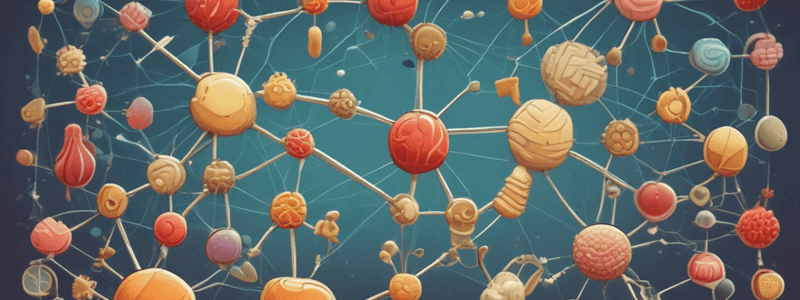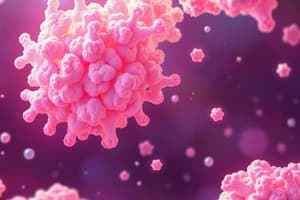Podcast
Questions and Answers
What is the significance of prefixes tri-, tetr-, pent- in a monosaccharide?
What is the significance of prefixes tri-, tetr-, pent- in a monosaccharide?
- Indicate the number of carbon atoms (correct)
- Indicate the type of isomerism
- Indicate the type of sugar
- Indicate the type of ring structure
What is characteristic of dihydroxyacetone?
What is characteristic of dihydroxyacetone?
- It has no optical activity
- It is a ketotriose (correct)
- It has a chiral carbon
- It is an aldohexose
What is the purpose of Fischer's projection and Haworth's formation?
What is the purpose of Fischer's projection and Haworth's formation?
- To show the alpha- and beta- anomers of monosaccharides
- To show the pyranose and furanose ring structures
- To show the D- and L- forms of monosaccharides
- To show the linear and cyclic forms of monosaccharides (correct)
What is the result of monosaccharides having asymmetric carbon atoms?
What is the result of monosaccharides having asymmetric carbon atoms?
What is the standard reference molecule used in carbohydrate chemistry?
What is the standard reference molecule used in carbohydrate chemistry?
What is the reason for monosaccharides forming rings?
What is the reason for monosaccharides forming rings?
Which monosaccharide is a structural isomer of glucose?
Which monosaccharide is a structural isomer of glucose?
What component leads to cataract if in excess due to enzyme deficiency?
What component leads to cataract if in excess due to enzyme deficiency?
Which disaccharide is commonly known as 'table sugar'?
Which disaccharide is commonly known as 'table sugar'?
Which monosaccharide is a major source of dairy products like milk?
Which monosaccharide is a major source of dairy products like milk?
In which type of proteins are L-arabinose and L-fucose commonly found?
In which type of proteins are L-arabinose and L-fucose commonly found?
Which type of bond is formed between two monosaccharides when joined together?
Which type of bond is formed between two monosaccharides when joined together?
What type of bond connects the glucose and fructose molecules in sucrose?
What type of bond connects the glucose and fructose molecules in sucrose?
What is the main function of oligosaccharides in the cell membrane?
What is the main function of oligosaccharides in the cell membrane?
Which type of sugar is less sweet and less soluble, found in mammalian milk?
Which type of sugar is less sweet and less soluble, found in mammalian milk?
What do blood group ABO substances represent on the surface of red blood cells?
What do blood group ABO substances represent on the surface of red blood cells?
Which sugar is a 6-carbon L-sugar in the chain gal - nag – gal – fuc?
Which sugar is a 6-carbon L-sugar in the chain gal - nag – gal – fuc?
How are polysaccharides characterized in terms of their size?
How are polysaccharides characterized in terms of their size?
What is the main component of chitin?
What is the main component of chitin?
Which polymer is recommended for the prevention and management of osteoarthritis?
Which polymer is recommended for the prevention and management of osteoarthritis?
In which polysaccharide is an anticoagulant found that is used in preventing blood clotting after surgery?
In which polysaccharide is an anticoagulant found that is used in preventing blood clotting after surgery?
What is the second type of monosaccharide present in heparin?
What is the second type of monosaccharide present in heparin?
Which polysaccharide is used in artificial skin and is composed of glucuronic acid and N-acetylgalactosamine?
Which polysaccharide is used in artificial skin and is composed of glucuronic acid and N-acetylgalactosamine?
What type of glycosidic bonds are present in chitin?
What type of glycosidic bonds are present in chitin?
What type of polysaccharides contain only α-glucose units?
What type of polysaccharides contain only α-glucose units?
Which molecule is a mixture of amylose (20%) and amylopectin (80%)?
Which molecule is a mixture of amylose (20%) and amylopectin (80%)?
How are glucose units linked in amylopectin?
How are glucose units linked in amylopectin?
Which heteropolysaccharides are commonly called glycosaminoglycans or mucopolysaccharides?
Which heteropolysaccharides are commonly called glycosaminoglycans or mucopolysaccharides?
What is the primary function of glycogen?
What is the primary function of glycogen?
What is the difference between ribose and deoxyribose?
What is the difference between ribose and deoxyribose?
Flashcards
Monosaccharides
Monosaccharides
The simplest form of carbohydrates, consisting of a single sugar molecule.
Triose
Triose
A monosaccharide with three carbon atoms.
Aldohexose/Aldopentose
Aldohexose/Aldopentose
A monosaccharide with six/five carbon atoms and an aldehyde group.
Cyclic form of monosaccharides
Cyclic form of monosaccharides
Signup and view all the flashcards
Haworth projection
Haworth projection
Signup and view all the flashcards
Isomerism in carbohydrates
Isomerism in carbohydrates
Signup and view all the flashcards
Aldose-ketose isomerism
Aldose-ketose isomerism
Signup and view all the flashcards
D- and L- forms
D- and L- forms
Signup and view all the flashcards
Enantiomers
Enantiomers
Signup and view all the flashcards
Disaccharides
Disaccharides
Signup and view all the flashcards
Glycosidic bond
Glycosidic bond
Signup and view all the flashcards
Hydrolysis of disaccharides
Hydrolysis of disaccharides
Signup and view all the flashcards
Sucrose
Sucrose
Signup and view all the flashcards
Maltose
Maltose
Signup and view all the flashcards
Lactose
Lactose
Signup and view all the flashcards
Oligosaccharides
Oligosaccharides
Signup and view all the flashcards
Polysaccharides
Polysaccharides
Signup and view all the flashcards
Chitin
Chitin
Signup and view all the flashcards
Hyaluronic acid
Hyaluronic acid
Signup and view all the flashcards
Heparin
Heparin
Signup and view all the flashcards
Study Notes
Monosaccharides
- Prefixes tri-, tetr-, pent- indicate the number of carbon atoms in the monosaccharide
- Simplest monosaccharides are trioses: glyceraldehyde (aldotriose) and dihydroxyacetone (ketotriose)
- Most carbohydrates of interest in human biochemistry are aldohexoses or aldopentoses
- Monosaccharides can exist in linear and cyclic forms
- Cyclic form can be represented in Haworth's formation or chair conformation
- Linear form is not very stable, so pentoses and hexoses tend to form rings for improved stability
Classification of Isomerism
- Aldose-ketose isomerism
- D- and L- forms
- Enantiomers, diastereomers, epimers
- Pyranose and furanose ring structures
- α- and β- anomers (anomerism)
Monosaccharide Structure
- Monosaccharides possess stereogenic centers (asymmetric carbon atoms)
- All carbohydrates contain at least one asymmetrical (chiral) carbon, except for dihydroxyacetone
- Glyceraldehyde is the standard reference molecule, and its presence confers optical activity
- Hormones such as insulin and glucagon are related to diabetes mellitus
Important Monosaccharides
- Fructose (C6H12O6): fruit sugar, sweeter than glucose, and has a structural isomerism with glucose
- Galactose (C6H12O6): found in dairy products, a component of lactose and glycoproteins in brain and nerve tissue
- Galactosemia: excess galactose results in cataract due to enzyme deficiency
Disaccharides
- Formed via condensation/dehydration reactions
- A H2O molecule is removed (condensation) from a pair of monosaccharide molecules when joined together
- The bond formed between 2 monosaccharides is called a glycosidic bond (O-glycosidic bond)
- Disaccharides can be hydrolyzed to form monosaccharide sub-units (reverse reaction)
Examples of Disaccharides
- Sucrose: glucose + fructose, commonly called "table sugar"
- Maltose: glucose + glucose, used to make malted candy
- Lactose: glucose + galactose, found in cow's milk
Oligosaccharides
- Contain 3-10 monosaccharide molecules which are liberated on hydrolysis
- Functions include cell recognition and cell adhesion in the cell membrane
- Normally present as glycans: oligosaccharide chains are linked to lipids or to amino acid side chains in proteins, by N- or O-glycosidic bonds
- Blood groups ABO substances are oligosaccharides present in most cells of the body and in certain secretions
Polysaccharides
- Large molecules > 10 monosaccharide units
- Joined by O-glycosidic linkages in one continuous chain or the chain may be branched
- Examples: chitin, hyaluronic acid, chondroitin sulfate, dermatan sulfate, keratan sulfate, and heparin
Examples of Polysaccharides
- Chitin: second most abundant polysaccharide in nature, found in crustaceans and insects, used as surgical thread that biodegrades as a wound heals
- Hyaluronic acid (hyaluronate): found in synovial fluid in joints, eye, and in connective tissues, provides lubrication and shock absorption
- Heparin: anticoagulant used in preventing blood clotting after surgery and in blood sample tubes
- Chondroitin 6-sulphate: found in connective tissues, tendons, and cartilage, used in artificial skin and recommended for the prevention and management of osteoarthritis
Studying That Suits You
Use AI to generate personalized quizzes and flashcards to suit your learning preferences.



